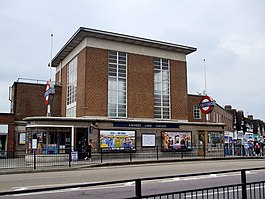Rayners Lane tube station
| Rayners Lane |
|
|---|---|
 |
|
|
Location of Rayners Lane in Greater London
|
|
| Location | Rayners Lane |
| Local authority | London Borough of Harrow |
| Managed by | London Underground |
| Number of platforms | 2 |
| Fare zone | 5 |
| London Underground annual entry and exit | |
| 2012 |
|
| 2013 |
|
| 2014 |
|
| 2015 |
|
| Key dates | |
| 1904 | Tracks laid (Metropolitan) |
| 1906 | Opened (Metropolitan) |
| 1910 | Start (District) |
| 1933 | End (District) |
| 1933 | Start (Piccadilly) |
| 10 August 1964 | Goods yard closed |
| Listed status | |
| Listing grade | II |
| Entry number | 1261430 |
| Added to list | 17 May 1994 |
| Other information | |
| Lists of stations | |
| WGS84 | 51°34′31″N 0°22′17″W / 51.5753°N 0.3714°WCoordinates: 51°34′31″N 0°22′17″W / 51.5753°N 0.3714°W |
|
|
|
Rayners Lane is a London Underground station in the district of Rayners Lane in north west London, amid a 1930s development originally named Harrow Garden Village. The station is on the Uxbridge branch of both the Metropolitan line, between Eastcote and West Harrow stations, and the Piccadilly line, between Eastcote and South Harrow stations. The station is located to the west of the junction of Rayners Lane, Alexandra Avenue and Imperial Drive (A4090). It is in Travelcard Zone 5. Just to the East of the station the Piccadilly and Metropolitan lines tracks join for services to Uxbridge and separate going towards Central London.
The Metropolitan Railway (Harrow and Uxbridge Railway) constructed the line between Harrow on the Hill and Uxbridge and commenced services on 4 July 1904 with, initially, Ruislip being the only intermediate stop. At first, services were operated by steam trains, but track electrification was completed in the subsequent months and electric trains began operating on 1 January 1905.
Progressive development in the north Middlesex area over the next two decades led to the gradual opening of additional stations along the Uxbridge branch to encourage the growth of new residential areas. Rayners Lane opened as Rayners Lane Halt on 26 May 1906, and was named after a local farmer called Daniel Rayner.
...
Wikipedia

